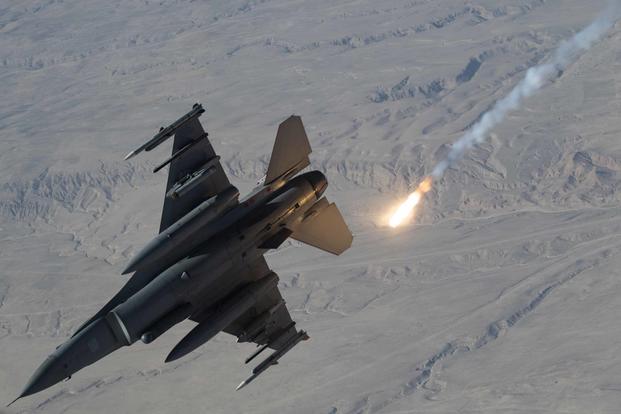The Afghanistan conflict just recorded the most U.S. airstrikes in a single month in nearly a decade.
Fighter, attack and remotely piloted aircraft together released 948 weapons on target during September, according to a recent strike report from Air Forces Central Command. The previous record, set in October 2010, saw aircraft release 1,043 bombs. Totals before that in the 18-year war are not readily available.
Should strikes continue at a high tempo in the months ahead, it's possible the U.S. will surpass its 2018 totals, which marked the most kinetic year for airstrikes in Afghanistan in at least a decade. Aircraft last year dropped 7,362 munitions, more than the three preceding years combined.
The latest report comes as the Trump administration in recent months has hinted it is open to drastically downsizing in the region, possibly even to withdrawing all 14,000 troops stationed there. But the move would require a peace deal with the Taliban, which President Donald Trump last month said was "dead" following a Sept. 5 suicide car bombing in Kabul, which killed a U.S. service member.
Related: Families of Afghanistan Fallen Fear Their Memorials Will Be Left Behind
Trump had been slated to meet with Taliban leaders at Camp David, Maryland, ahead of the Sept. 11 anniversary. He suspended the talks, citing the suicide bombing attack.
"We had peace talks scheduled a few days ago," Trump said during the 9/11 ceremony at the Pentagon. "I called them off when I learned that they had killed a great American soldier from Puerto Rico and 11 other innocent people."
He continued, "They thought they could use the attack to show strength, but actually what they showed is weakness. The last four days, we have hit our enemy harder than they have ever been hit before, and that will continue."
Even as talks between the U.S. and the Taliban have wavered this year, aircraft have kept busy. According to the data, the number of sorties flown by manned aircraft that included at least one weapons release have nearly quadrupled from last year -- 500 in 2018 compared to 1,838 so far this year.
"We did step up our attacks on the Taliban since the talks broke down," Defense Secretary Mark Esper told reporters during a recent trip to Wright-Patterson Air Force Base, Ohio. "We did pick up the pace considerably.
"The president did want us to pick up in response to those heinous attacks that the Taliban and others conducted throughout Afghanistan," he said Oct. 5, adding that the uptick includes "both air and ground" assets.
Meanwhile, targeted strikes on Islamic State militants in Iraq and Syria have dwindled.
U.S. military aircraft dropped 137 total munitions on ISIS targets last month, according to the data. By comparison, aircraft released 758 weapons for the same month last year, and 3,550 for September 2017.
-- Oriana Pawlyk can be reached at oriana.pawlyk@military.com. Follow her on Twitter at @Oriana0214.
Read more: This Soldier Amputated His Own Leg to Help Save His Comrades When Their Tank Crashed












